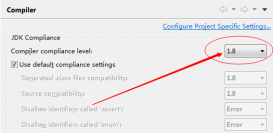本文基于jdk1.8来分析arraylist的源码
首先是主要的成员变量。
|
1
2
3
4
5
6
7
8
9
10
11
12
13
14
15
16
17
18
19
20
21
22
23
24
25
26
27
|
/** * default initial capacity. **/private static final int default_capacity = 10;/** * shared empty array instance used for empty instances. **/private static final object[] empty_elementdata = {};/** * shared empty array instance used for default sized empty instances. we * distinguish this from empty_elementdata to know how much to inflate when * first element is added. **/private static final object[] defaultcapacity_empty_elementdata = {};/** * the array buffer into which the elements of the arraylist are stored. * the capacity of the arraylist is the length of this array buffer. any * empty arraylist with elementdata == defaultcapacity_empty_elementdata * will be expanded to default_capacity when the first element is added. **/transient object[] elementdata; // non-private to simplify nested class access/** * the size of the arraylist (the number of elements it contains). * * @serial **/private int size; |
其中初始大小为10,size表示集合中元素的个数。此外,还有两个空数组empty_elementdata,和defaultcapacity_empty_elementdata。通过defaultcapacity_empty_elementdata的注释,我们可以了解到,这个变量区别于empty_elementdata,主要是为了决定第一个元素插入时,扩容多大的问题。从这里的描述可以理解到,arraylist创建好后,其实并没有真正分配数组空间,而是在第一个元素插入时,才分配的空间。这一点是区别于jdk1.6的。在jdk1.6中,arraylist一创建,数据空间就默认分配好了,10个或指定的空间。jdk1.8这么做,可以做到空间延迟分配,提高程序性能。
接下来看一下构造函数。
|
1
2
3
4
5
6
7
8
9
10
11
12
13
14
15
16
17
18
19
20
21
22
23
|
/** * constructs an empty list with an initial capacity of ten. **/ public arraylist() { this.elementdata = defaultcapacity_empty_elementdata; }/** * constructs an empty list with the specified initial capacity. * * @param initialcapacity the initial capacity of the list * @throws illegalargumentexception if the specified initial capacity * is negative **/ public arraylist(int initialcapacity) { if (initialcapacity > 0) { this.elementdata = new object[initialcapacity]; } else if (initialcapacity == 0) { this.elementdata = empty_elementdata; } else { throw new illegalargumentexception("illegal capacity: "+ initialcapacity); } } |
无参构造函数,将创建一个长度为0的空数组。
有参构造函数,参数大于0时正常创建数组,参数为0时,也是创建长度为0的数组。但它和无参构造函数创建的空数组是可以区别开的,它们使用了不同的对象。
接下来是插入元素add。
|
1
2
3
4
5
6
7
8
9
10
11
12
13
14
15
16
17
18
19
20
21
22
23
24
25
26
|
/** * appends the specified element to the end of this list. * * @param e element to be appended to this list * @return <tt>true</tt> (as specified by {@link collection#add}) **/ public boolean add(e e) { ensurecapacityinternal(size + 1); // increments modcount!! elementdata[size++] = e; return true; } private void ensurecapacityinternal(int mincapacity) { ensureexplicitcapacity(calculatecapacity(elementdata, mincapacity)); } private static int calculatecapacity(object[] elementdata, int mincapacity) { if (elementdata == defaultcapacity_empty_elementdata) { return math.max(default_capacity, mincapacity); } return mincapacity; } private void ensureexplicitcapacity(int mincapacity) { modcount++; // overflow-conscious code if (mincapacity - elementdata.length > 0) grow(mincapacity); } |
通过calculatecapacity函数,我们可以知道,如果是用new arraylist()创建的list,第一次add元素,计算得mincapacity = 1。如果是new arraylist(0)创建的list,计算得mincapacity = 10. 然后再根据mincapacity去grow。
get方法比较简单,这里不再分析。
arraylist的一个常见问题是concurrentmodificationexception,同步修改异常,也称为快速失败,fast-fail。当我们以foreach方式遍历arraylist时,如果在遍历过程中删除arraylist的元素,或者别的线程往arraylist中添加元素,就会抛出该异常。这里需要注意,以for(int i = 0; i < list.size(); i++)的方式遍历arraylist时,是不会抛出同步修改异常的,但用这种方式遍历,需要处理好i的前进速度。
那么,用foreach方式遍历arraylist为什么会抛出同步修改异常呢?
foreach代码的底层实现,是用iterator对arraylist进行遍历,在遍历过程中,会持续调用next获取下一个元素。next方法中,会首先checkforcomodification(),它的作用是检查modcount和expectedmodcount是否相等。不相等时,则抛出同步修改异常。那么什么情况下修改次数和期望修改次数不相等呢?这里需要首先弄明白,modcount和expectedmodcount是什么东西?modcount是arraylist从它的父类继承来的属性,记录了集合的修改次数,add,remove时都会给modcount加1. expectedmodcount是迭代器的成员变量,它是在创建迭代器时,取的modcount的值,并且,在遍历过程中不再改变。那么就清楚了,expectedmodcount其实是开始遍历时modcount的值,如果在遍历过程中,arraylist进行了add或remove操作,那么必然导致expectedmodcount和modcount不相等,于是就抛出了同步修改异常。
|
1
2
3
4
5
6
7
8
9
10
11
12
13
14
15
|
public e next() { checkforcomodification(); int i = cursor; if (i >= size) throw new nosuchelementexception(); object[] elementdata = arraylist.this.elementdata; if (i >= elementdata.length) throw new concurrentmodificationexception(); cursor = i + 1; return (e) elementdata[lastret = i];}final void checkforcomodification() { if (modcount != expectedmodcount) throw new concurrentmodificationexception();} |
那么,同步修改异常如何避免呢?或者说,我们如何遍历集合并把其中的某些元素删除呢?
答案是使用迭代器的remove方法删除元素。在迭代器的remove方法中,删除元素后,会重新把modcount赋值给expectedmodcount,所以,它不会抛出同步修改异常。
|
1
2
3
4
5
6
7
8
9
10
11
12
13
|
public void remove() { if (lastret < 0) throw new illegalstateexception(); checkforcomodification(); try { arraylist.this.remove(lastret); cursor = lastret; lastret = -1; expectedmodcount = modcount; } catch (indexoutofboundsexception ex) { throw new concurrentmodificationexception(); } } |
总结
以上就是这篇文章的全部内容了,希望本文的内容对大家的学习或者工作具有一定的参考学习价值,谢谢大家对服务器之家的支持。如果你想了解更多相关内容请查看下面相关链接
原文链接:https://blog.csdn.net/li_canhui/article/details/85001591












